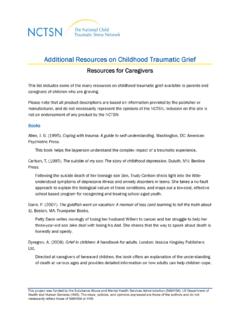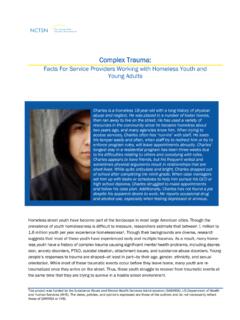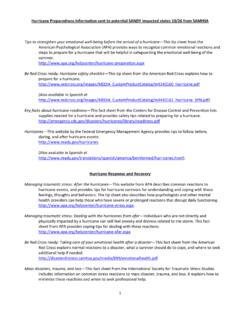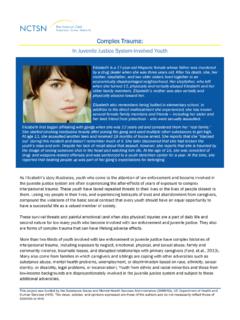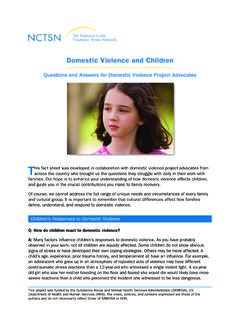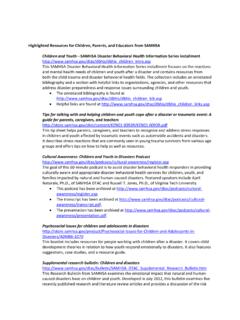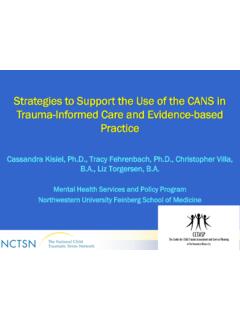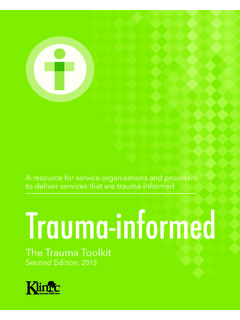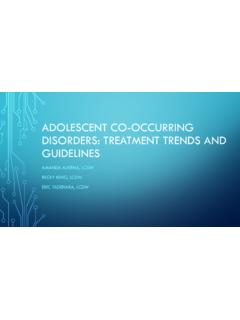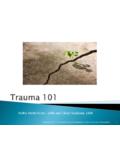Transcription of Manual for Group Cognitive-Behavioral Therapy of Major ...
1 Manual for Group Cognitive-Behavioral Therapy of Major Depression A Reality Management Approach (Instructor s Manual ) Ricardo F. Mu oz, Chandra Ghosh Ippen, Stephen Rao, Huynh-Nhu Le, Eleanor Valdes Dwyer, Drawings by Erich Ippen, Cognitive-Behavioral Depression Clinic Division of Psychosocial Medicine San Francisco General Hospital University of California, San Francisco May, 2000 Copyright 2000 Mu oz, Ghosh Ippen, Rao, Le, & Dwyer iiTABLE OF CONTENTS The cognitive behavioral Therapy Approach.. iv The Reality Mangement Approach: An introduction .. vii Overview of Instructors Guidelines .. xv General Contents of a Session.. xxiv Agenda and Announcements.. xxiv Review.. xxiv Personal Project Review.. xxv New Material.
2 Xxvi Take Home Message.. xxvi Personal Project Assignment.. xxvi Feedback and Preview.. xxvii Group Leader Self Evaluation Form.. xxviii References.. xxix Introduction: Session 1 of each module.. Introduction-1 Agenda and Announcements.. Introduction-1 Group Rules.. Introduction-1 Introductions.. Introduction-2 Review the Symptoms of Depression.. Introduction-3 Depression information sheet.. Introduction-4 Cognitive-Behavioral Treatment Model.. Introduction-5 Thoughts 1: Thoughts and your mood.. 1 Thoughts 2: Identifying helpful/positive and harmful/negative patterns of thinking.. 11 Thoughts 3: Decreasing and talking back to your negative thoughts to improve your mood.. 22 Thoughts 4: Increasing your helpful thoughts to improve your mood and using thoughts to live the life you want.
3 29 Activities 1: Activities and your mood.. 36 Activities 2: Relaxing and planning to do pleasant activities.. 44 Activities 3: Identifying and overcoming roadblocks to doing pleasant activities.. 58 Activities 4: Setting goals and shaping your reality.. 69 People 1: People contacts and your mood.. 82 iiiPeople 2: Interpersonal relationship problems and feelings, thoughts, and behaviors.. 97 People 3: Improve your relationships and manage your mood.. 111 People 4: More tools to improve your relationships and your mood.. 120 Health 1: Understanding the relationship between depression and health. 131 Health 2: Depression, Poverty, and Health .. 145 Health 3: Depression, Sleep, and Health.. 154 Health 4: Depression, Other Emotions, and Health 165 Center for Epidemiological Studies Depression Scale (CES-D) 173 San Francisco General Hospital Depression Clinic Mood Check-Up 174 cognitive behavioral TREATMENT FOR DEPRESSION PART II: Lecture Notes for Instructors: Overview Version 2000: May, 2000 iv THE cognitive behavioral Therapy APPROACH Preface: Origins of this CBT Manual The first version of this Manual was developed for a randomized controlled trial that found that each of three distinct components of Therapy (increasing pleasant activities, interpersonal skill training, or changing the way patients think) were similarly efficacious in treating depression relative to a control condition (Zeiss, Lewinsohn, & Mu oz, 1979).
4 The study was directed by Peter M. Lewinsohn, , as the dissertation chair for the three other members of the team that conducted the study, Ricardo F. Mu oz, Mary Ann Youngren, and Antonette Zeiss. These four authors of the original manuals combined them and published them as a self-help book titled Control Your Depression (Prentice Hall, 1978, revised 1986). The book was then adapted by Mu oz in 1983 as the Depression Prevention Course, an 8-session Manual for a randomized controlled depression prevention trial with Spanish- and English-speaking primary care patients at San Francisco General Hospital. Excerpts of the course can be found in Appendix A of The Prevention of Depression: Research and Practice, by Mu oz and Yu-Wen Ying (Johns Hopkins University Press, 1993).
5 The development of several other manuals, including the current one, is depicted in Figure 1. In 1985-1986, the Depression Prevention Course was expanded into a 12-session format for use at the University of California, San Francisco (UCSF)/San Francisco General Hospital (SFGH) Depression Clinic. This bilingual (Spanish/English) clinic was founded in 1985 by Mu oz, Jeanne Miranda, and Sergio Aguilar-Gaxiola to provide treatment to low-income depressed patients referred by their primary care physicians. The clinic, directed by Mu oz, was the first outpatient mental health clinic at SFGH. The Depression Clinic Manual , titled Group Therapy Manual for Cognitive-Behavioral Treatment of Depression was prepared in English (Mu oz & Miranda, 1986) and Spanish (Mu oz, Aguilar-Gaxiola, & Guzm n, 1986).
6 Both the 8-session Depression Prevention Course and the 12-session Group CBT Manual retained the three-pronged focus on activities, thoughts, and people from the manuals of the original study, because these are key areas that influence depressed mood, and thus can be used to treat it. Most depressed patients find one or more of these areas useful to gain greater control over their depressed mood. In 1995, the Psychosocial Medicine Division at SFGH opened up an outpatient clinic which included the Depression Clinic under its larger umbrella. Now called the Cognitive-Behavioral Depression Clinic, it has continued to provide clinical services and training in Cognitive-Behavioral Therapy . In 1999-2000, Mu oz, two postdoctoral Fellows at UCSF, Huynh-Nhu Le and Chandra Ghosh-Ippen, the coordinator of the Depression Clinic, Eleanor Valdes Dwyer, and the Director of the Psychosocial Medicine Outpatient Clinic, Stephen Rao, decided to revise and expand this Manual into a 16-session format, also prepared in Spanish and English.
7 In addition to the three modules on thoughts, activities, and people, we added a module on the relationship of health issues and depression. Our patients are referred to us by primary care physicians, and, therefore, most have medical problems which affect the course of their depression. Following the structure of the Depression Prevention Course, we have also added an instructor s Manual to accompany the participant s Manual . Our intent is to make it easier for Group leaders to use the protocol as intended. With the instructor s Manual , the CBT protocol can be used more easily in the training of new therapists. cognitive behavioral TREATMENT FOR DEPRESSION PART II: Lecture Notes for Instructors: Overview Version 2000: May, 2000 v Acknowledgements We want to acknowledge the intellectual contributions of Peter M.
8 Lewinsohn, whose pioneering work on behavioral approaches to depression guided the creation of the three initial manuals, as well as Albert Bandura, whose conceptual contributions in books such as Social Learning Theory (Prentice Hall, 1977), also provided direction for the development of these interventions. At the San Francisco General Hospital Depression Clinic, many individuals helped shape the treatment approaches used. Among them are Jacqueline Persons and Charles Garrigues, who were very influential during the early stages of the clinic. We also want to acknowledge the many other Depression Clinic colleagues and trainees who assisted in the revision of this Manual : Jennifer Alvidrez, Patricia Are n, Francisca Azocar, Drew Bertagnolli, Colleen Holt, Manuela Iturrioz, Gayle Iwamasa, Kathleen MacCormick, and Kurt Organista.
9 A special thanks to the co-authors of the 12-session Group CBT Manual (1986 version), Sergio Aguilar-Gaxiola, John Guzm n, and Jeanne Miranda. The contributions of all of these colleagues are embedded in these pages. Since this time, the Manual has also been adapted for use with other populations, such as African-American women, by Laura Kohn, and for other clinical problems, including work with methadone maintenance patients, psychiatric inpatients, and smokers. Jeanne Miranda worked at the Depression Clinic for ten years. For the last five (1990-1995), she was the Director of the Clinic. Since then, she has continued to work in the area of depression in primary care. In work done in collaboration with Kenneth Wells at UCLA/RAND, she has demonstrated that the 12-session manuals can be helpful in quality improvement programs to enhance the care for depression received by primary care patients.
10 The work of Wells, Miranda, and colleagues has appeared in the Journal of the American Medical Association (January, 2000) and other professional journals. Organization of Manual The revised Manual includes two parts: (a) an instructor s Manual , and (b) a participant s Manual . The instructor s Manual is organized as follows: 1. An introduction, including a brief explanation of the reality management approach, the social learning basis for this type of Cognitive-Behavioral treatment for depression, key elements of this approach, the need for rapport-building interviewing methods, levels of CBT intervention, and potential pitfalls. 2. An overview of guidelines for instructors, including the basics of Group Therapy , strategies to teach main concepts, and ways to attend to Group processes.
